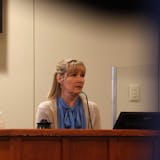Buses and light rail in the Twin Cities have become a homeless shelter of sorts, prompting Metro Transit to come up with a new initiative to deal with the issue.
About 180 to 250 homeless people ride each night, Metro Transit Police Chief John Harrington said Tuesday.
"For one, transit is safe. … It is a dry and a sanitary space," the chief said.
In a report to legislators Tuesday, Harrington also said more officers are on buses and light rail for security reasons and that service calls have gone up dramatically.
However, he said more serious crimes have gone down compared to last year.
"Transit is in fact one of the safest places in the Twin Cities area," Harrington said during the House Transportation Committee finance meeting.
Yet, legislators think more could be done to prevent crimes.
"I think we all need to be honest with what's going on in our communities," said the committee's chairman, Rep. Paul Torkelson, R-Hanska.



